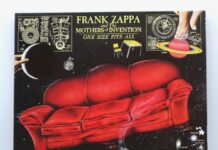In terms of unorthodox career paths in the music business, there is probably no match for the Italian proggers, GOBLIN, with their back catalog being comprised of mostly horror film soundtracks. Their most acclaimed works date back to the 1970s, although the soundtrack album they did for the Night of the Living Dead sequel, Dawn of the Dead, is their best-known effort to date outside the horror-film nerd demographic. The band’s roots sprawled out from several other 1970s Italian prog outfits. Bandleader-keyboardist Claudio Simonetti and original drummer Walter Martino both had played in RITRATTO DI DORIAN GRAY, a group inspired by Irish playwright Oscar Wilde, I presume; guitarist Massimo Morante had played in ERA DI ACQUARIO, and bassist Fabio Pignatelli had come from RIVELAZIONI. Reinforced with vocalist Tony Tartarini, this bunch originally called themselves THE CHERRY FIVE, playing British-style progressive rock in the vein of YES, GENESIS, and ELP. Their debut for the Italian Cinevox label failed miserably but caught the ear of film director Dario Argento who was working on the film, Profondo Rosso, at the time. Argento contacted the band and asked them to rework the half-completed score left behind by the composer, Giorgio Gaslini. The guideline was that the soundtrack should be taken in a tad heavier direction. The band took the job and, in keeping with the horror theme, changed its name to GOBLIN – and the rest is history. For some reason, it is near-impossible to find the original release date from any reliable online source, but this Italian giallo film classic premiered on March 7th, 1975, in Italy, so I would assume the soundtrack was released around that time, as well, meaning that this relatively short, 30-minute symphonic-prog curiosity is celebrating its 50th anniversary right about now. Despite the band’s new name, the soundtrack was still released on their old label, Cinevox. Had OPETH not paid homage to GOBLIN on their 2014 album “Pale Communion” by naming one of the tracks after this Italian group, I probably wouldn’t know anything about this beautiful album.
The title track opens the album like a picture-perfect calling card of the band’s grandiose signature sound centered around Simonetti‘s keyboard wizardry and guitarist Massimo Morante‘s almost Mike–Oldfield-esque guitarism. I haven’t seen the film but I’ve been told that it is quite surreal, even for a horror film, and the music on this soundtrack does suggest something to that effect. Unlike with modern horror film soundtracks, the modus operandi here is not about throwing musical jump scares here and there; rather, the suggestion that something evil is about to happen is left hanging in the air by those slightly unsettling keyboard ostinatos and churchy organ breaks. The opening keyboard riff has a nice familiar feel – it must have been the one inspiring that OPETH banger. The last organ cadence, in turn, triggered flashbacks of the coda in FAITH NO MORE‘s 1992 hit, “Small Victory.”
Next, “Death Dies” represents murder-scene music, channeling the evil funk genius of Herbie Hancock of the era – his greatest contribution to electrified funk “Headhunters” came out in 1973. The drummer on this track, Agostino Marangolo, would later replace Walter Martino as a full-time member of the group. Maybe it’s his funky drumming, echoing fusion-jazz greats such as Billy Cobham, that makes this track lean substantially more toward jazz-rock fusion than progressive rock.
These first two tracks lay out the blueprint for the whole album; the rest of the songs fall in line either with the symphonic prog-rock framework or reach out to fusion realms. “Mad Puppet” is perhaps the weird one out that isn’t either. After an artsy intro of sci-fi bleeps, the song evolves into a riffathon recalling the lysergic pop of the late 1960s. The main riff could be from THE BEATLES but the band still refrains from going into a full-on pastel-shaded hippie mode.
Then, if the free-jazz saxophone licks and ominously “chonky” piano stabs in “Wild Session” do not scare the unsuspecting Radio Nova listener away, the disquieting jazz mayhem of “Deep Shadows” probably will. The song is not necessarily as reckless and wild as “Bitches Brew” era Miles Davis but I get the feeling that these Italian gents must have been aware of that landmark fusion album – it was released in 1969.
“School at Night” with its creepy chamber music might not exactly qualify as symphonic prog, per se, but as those pioneering prog-rock dinosaurs flirted rather openly with classical music in the heyday of progressive rock, I would rather file the song in that category. It sure as hell isn’t jazz music. The strange bossa-nova-like closer, “Gianna,” most likely is, for that matter. There is no polite way to say it, so I just blurt it out – it’s one hell of a weird, if not even surreal choice for a closer. After six tracks of electrified rock-jazz fusion and unsettling prog-rock soundscapes, the album is brought to a close with a short piece of overtly happy-go-lucky elevator music. Then again, I have to remind myself that this album was made as a soundtrack for a film. This is where the story ends on a happy note, I guess.
There is a rather distinct difference between the original vinyl sides; the first half of the album, the suspense-filled instrumentals representing vinyl side A, was composed by GOBLIN, exclusively; the latter half, the jazz-rock fusion-tinged tracks representing vinyl side B, were originally composed by Gaslini and feature orchestral arrangements, whipped up by the band’s organic and chunky grooves – “Gianna” maybe notwithstanding. Murder and mystery are the main ingredients of this rare prog-rock endeavor from 50 years ago. As an album, it might require a specific taste for the strange to be regarded as perfect even though it’s too short to become annoying even for the AD/HD video game generations but, as far as soundtracks go, it is a visceral, cinematic triumph of spaced-out progressive rock. Mixing elements of jazz and classical into the somewhat blues-derivative British prog-rock template of the era, GOBLIN embarked on a career path somewhat similar to KING CRIMSON but added a distinct layer of funk to the mix. By doing so, they single-handedly laid down the template for many a future zombie film soundtrack to come.
Written by Jani Lehtinen
Tracklist
- Profondo Rosso
- Death Dies
- Mad Puppet
- Wild Session
- Deep Shadows
- School at Night
- Gianna
Lineup
Massimo Morante – guitars
Claudio Simonetti – keyboards
Fabio Pignatelli – bass
Walter Martino – drums
With additional musicians:
Giorgio Gaslini – orchestral score & conductor (tracks 4 – 7)
Agostino Marangolo – drums on track 2
Label
Cinevox






